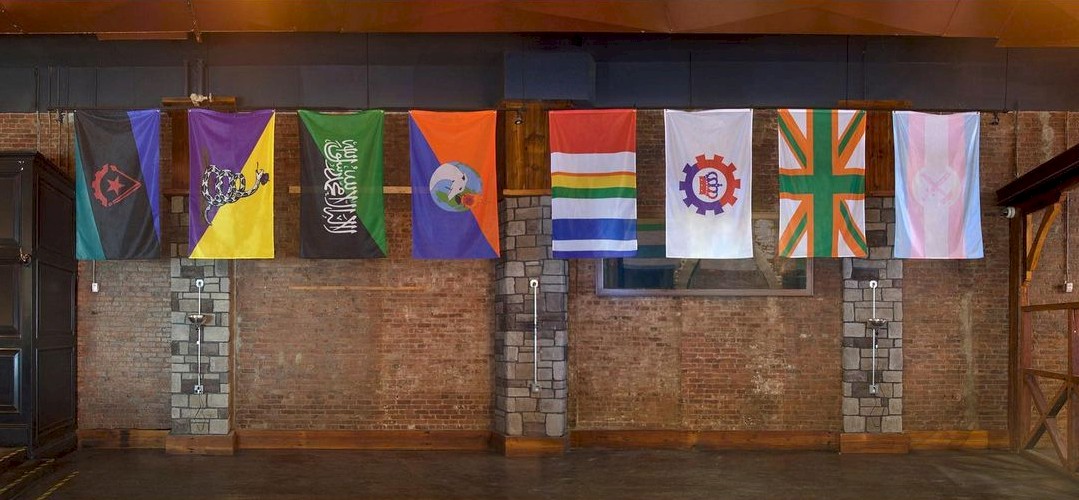
 Pax Cultura, The Banner of Peace a symbol of the Roerich Pact that represented a deep and sophisticated understanding of the nature of existence.
Pax Cultura, The Banner of Peace a symbol of the Roerich Pact that represented a deep and sophisticated understanding of the nature of existence.
 African American Flag created by David Hammons by combining the US starts and stripes with the colours from the Pan-African Flag.
African American Flag created by David Hammons by combining the US starts and stripes with the colours from the Pan-African Flag.
 Hesselholdt & Mejlvang, "Native, Exotic, Normal / Circle of Flags" at Roskilde. Photo by Lone Eriksen
Hesselholdt & Mejlvang, "Native, Exotic, Normal / Circle of Flags" at Roskilde. Photo by Lone Eriksen
 Black Lives Matter flag at the 2017 Minneapolis MayDay Parade
Black Lives Matter flag at the 2017 Minneapolis MayDay Parade
 Joshua Citarella, "e-deologies", 2020, Dye Sublimation Print on Polyester, each 60 x 36
Joshua Citarella, "e-deologies", 2020, Dye Sublimation Print on Polyester, each 60 x 36
Signals crossed
When Neil Armstrong landed on the Moon, as a way of marking the territory he put a flag on it. After all, it’s human nature to fight for power by creating compelling spectacles, to impose dominance by using symbols as an extension of our thought and vision. We will never know if that spectacle was pre-recorded in the film studio, but even with that particular imperialist US flag symbolically signaling the domination in the endless cosmic realm, the wholeness of the universe was too much to grasp. Humans may have never returned to the Moon but the flag they initially placed there served well as a form of their branding.
The holistic ambition for the conquest of the Moon might have been prevented by the aliens and their normative frame, but frankly, the national flag never had a chance in the vast cosmos. Curiously enough when the first man, Juri Gagarin, flew into space, he represented the Krushchev-led Soviets and they did something visionary. They sent him with a Banner of Peace, bearing a Pax Cultura emblem, a symbol of the Roerich Pact that represented a deep and sophisticated understanding of the nature of existence (past, present, future or Art, Science, Religion etc).[1]
Signal for…
The flag for some crowds represents national territory: a way of identifying a sense of belonging to a place. Even for partially recognized or unrecognized states (e.g. Akhbazia, Transnistria) who do not have the solidity of territory, the flag aims to replace the missing identity. The flags by definition depict the symbol of union, often even the union of opposites, and thus they aim to establish order in presumed chaos. However, in challenging times, when the chaos gets more chaotic, flags transform, deconstructed by their representation and their meaning entirely expanded. In Poland, this Autumn, flags made out of golden thermal blankets were used in the march of Solidarity with the migrants.
Reasons for the change of the flag’s function can be purely practical. For example, “the seven flags theory” is a strategy that suggests the creation of a diversified international structure so that a person’s business and wealth doesn’t depend on, for practical reasons, any specific government. These flags serve the purpose of protecting the capital of wealthy people. A sportsmen residing in Monaco may pick up a flag of the country that protects their assets in the most lucrative way,[2] confirming that the most important role of branding in the 21st century is to support the consumer and make a difference in their lives.[3] The Zapatista’s flag, standing for “the territory of rebellion where people command and the government obeys”, stands in opposition to capitalism and far from the affluent manipulating flags to avoid taxes. Yet it uses the same idea of the flag as a statement of branding, albeit a different movement.
Mixed Signals
As a result of diversified social dynamics, driven by the change in the value system and the character of desire, even the oldest flag in the world has been challenged. It took for Muhammed’s drawing to induce tension and conflict in/around the Danish flag (‘Dannebrog’),[4] pointing to the fact that the flags as a brand can provoke a gap between the desired perception and their understood reality.[5 ]This particular Danish flag example was so divisive that it opened reactions from both the arts and politics. While the Superflex collective aimed to deconstruct the flag by redesigning the flames on it, the right-wing party started a brainwashing campaign that reinforced it as a symbol of power. On various occasions, Hesselholdt & Mejlvang, a Danish female duo, elaborated further by means of politics and aesthetics on the solidity of the Danish flag. Initially, they painted it black, anarchistically treating the white supremacy that it represents only to be prosecuted by the police. The prosecution concluded that the flag belonged to the domain of fantasy and was not to be judged further. Hesselholdt & Mejlvang’s Flags of Aggression (2014) were followed by the pale flags that depicts a range of six skin tones, embracing all human skin colours in Native, Exotic, Normal / Circle of Flags (2016). They also sarcastically sewed together several national flags in Skin Color Union, (2015) only to ridicule it in their last performance Two Fools and a Pole (2021).
Smoke Signals
As always, art anticipates the change in politics. It was in 1990 that the artist David Hammons designed the famous African American Flag by combining the US flag and the Pan-African Flag from 1920. Hammons made the flag for the Black USA exhibition at Amsterdam’s Museum Overholland in response to the fact that no African-American women featured. However, it was only in May 2021, that the Black Lives Matter flag, representing the branding of a decentralized movement, got its official status as it was authorized to hang on the US international posts to promote racial justice overseas.
“Mundane” Flags[6]
While the totality remains unattained, the great acceleration transforms the world beyond the obsession with the planetary and the geographical, beyond our own and known. More than that, flag design also has to adapt and cater for diversification and for different forms of distribution: the wounds, the cuts, the in-between, the obscured, the underrepresented, the uncanny, the chemical, the geological, the biopolitical, the inhuman. Brainwashing, greenwashing, pinkwashing, all open the opportunity for rebranding. To design a print-on-demand flag today is to design for versatile, otherwise unknown and underrepresented wounds and vulnerabilities.
The Covid-19 induced pandemic has provoked a biopolitical war radically dividing people into vaxxers, anti-vaxxers and the rest, substituting and augmenting national flags and passports with vaxxing certificates. Battle for dominance, induced by fear, branded by Big Pharma and the opposition.
Different biopolitcs are promoted by Hamja Ahsan, the author of the book “Shy Radicals, The Antisystemic Politics of the Militant Introvert” who served for the otherwise disempowered cause by creating a flag for his utopian state of Aspergistan. The movement's motto is printed on the flag: 'The World is our Corner’ and aims to capture the attention of the alike, to trigger their emotions and create the space of their belonging. By raising the flag of Aspergistan he stood against the “hegemony of the Extrovert World Order”, aspiring to rid themselves of the shackles of “Extrovert Supremacism”. The flag stands for “the richness of inner life”, found not through territory but such marginalized activities as “silence, contemplation, intimate company”.[7] Rather than wanting to dominate, these flags aim to provoke empathy and compassion.
Virtue Signaling? Or do we take care of our mutual own?[8]
The shift from belonging to a territory to belonging to the undisciplined multitudes of a cause is provoked further by the ecological emergency. Be it tax evaders or Zapatista, anarchists or introverts, vaxxers or anti-vaxxers. each of them wave their particular flag, fighting their own battle for dominance. However, otherwise antagonistic multitudes might all have to be ruled under the flag branded: “survival”. All are forced to dive deeper into “the depth” for Earth in order to criticize the symptoms of extractivism.
The Western Flag (2017) by John Gerrard made visible the hidden gas responsible for climate change.[9] Shared worldwide as clips and stills it depicts the site of the 'Lucas Gusher' - the world's first major oil find in Spindletop, Texas in 1901 - now barren and exhausted. The site is recreated as a digital simulation, the center of which is marked by a flagpole spewing an endless stream of black smoke,[10] Flying our flag of self-destruction, John Gerrard asked us to consider our role in the warming of the planet and simultaneous desertification of once fertile lands. However, considering the role of the digital realm in heating up the planet, these digital flags tend to be controversial and hypocritical.
Old territories are being reevaluated and expanded with an ethical character that was not acknowledged before, while new territories that are emerging in the metaverse aim, at least nominally, for decentralization.
To produce a contemporary symbolic grasp of the multi-faceted world-image in the time of digital humanism and techno-feudalism, artists and designers are supported by programmers in their teams. Consisting of found images gathered in young political spaces online, Joshua Citarella’s “e-deologies” (2020), represents “niche personal branding in the chaotic landscape of online politics.”
But maybe, the flags of tomorrow are about artificially intelligent pattern recognition based on norms unimaginable to humans? Maybe flags will be a constantly evolving individual identity-play, fluctuating hybrids that will strategically prevent individuals from taking sides because in the metaverse, identity can be changed from one moment to the next.
What flag will you rise to in a transforming world? Will you hold a flag of a territory, or for a cause or movement? Will it be your own or our own? Or will you leave it up to Artificial Intelligence?
Reference
1. Nikolai Konstantinovich Rerikh was a Russian painter, writer, archeologist, theosophist, philosopher, and public figure. In his youth he was influenced by Russian Symbolism, a movement in Russian society centered on the spiritual. He was interested in hypnosis and other spiritual practices and his paintings are said to have a hypnotic expression.
2. “7 flags theory” stands for the residency of taxation, offshore company, offshore banking, digital assets, digital security and physical assets.
3. Rick Warren, The Purpose of Driven Life: What on Earth Am I Here For?, 2002.
4. Danish cloth.
5. Re Perez, Your Brand Should be Gay (Even If You’re Not), 2020.
6. Nick Foster, The Future Mundane, https://vimeo.com/139358108
7. 'Shy Radicals': The book that demands an inclusive world for introverts, https://www.middleeasteye.net/discover/shy-radicals-hamja-ahsan-world-our-corner?fbclid=IwAR1wLBSu8DHqgH2y2NJw3pafbAd4H680PmhO6SUnf_-BYUNyN_8cQkF6Je
8. As Bruce Springsteen puts it: “Wherever this flag is flown, we take care of our own”.
9. The computer generated Spindletop runs in exact parallel with the real site in Texas throughout the year: the sun rising at the appropriate times and the days getting longer and shorter according to the seasons. The simulation is non-durational (having no beginning or end) and is run live by software that calculates each frame of the animation in real-time as it is needed. this former sea floor with an abundance of life, but of the energy taken to return the deserted land to its current state of artificial habitation. See it live on sim.stream or flare.johngerrard.net
10. The flag is also minted a singular NFT that supports regenerate.farm and a crypto fund for climate and soil.